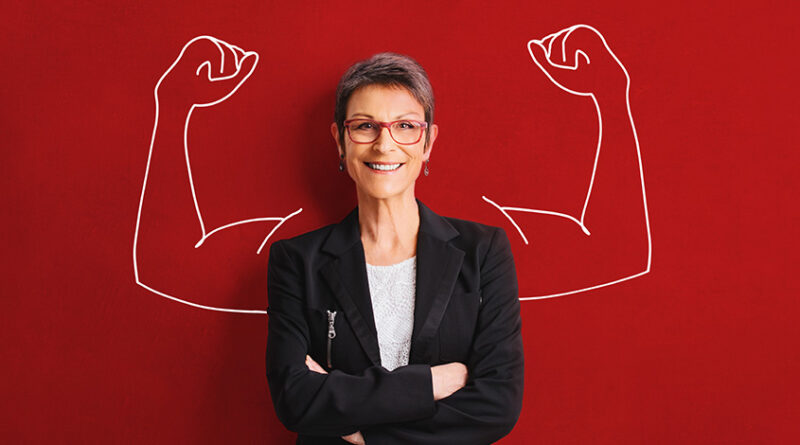Gaining Muscle at 55-Plus
We all lose muscle mass as we age, but local trainer say people can grow muscles if they are willing to follow an exercise regimen
By Deborah Jeanne Sergeant
People begin to lose as much as 3% to 5% of their muscle mass per decade beginning at age 30, according to Harvard Medical School.
Most men will lose 30% of their muscle mass over their lifetime.
But that does not mean that it is impossible to fight the effects of aging on muscle mass.
“You can still grow muscle after 55,” said Jennifer Johnson, certified personal trainer and owner of Fearless Fitness in Baldwinsville. “It may not be as much when you get older, but if you’re lifting heavy enough, you can grow muscle.”
She said that training changes, but the basic mechanisms of gaining muscle remain the same. She advises many of her clients who are 55-plus to increase the amount of weight they are lifting because many lift too little.
“Women especially are afraid they will get too big and bulky,” Johnson said. “That won’t happen.”
She encourages clients to push themselves just enough to grow muscle, but not so much that they are at risk for injury. It should not cause pain while lifting, but “you will be sore the next day, showing that you are growing muscle,” she said.
Changing the routine can help muscle growth instead of doing the same thing repeatedly.
“You need to create muscle confusion which keeps your body on edge,” Johnson said. “Do heavier weight, try something different and you’ll see results faster instead of just doing light weights over and over.”
She mixes up her clients’ routines with fitness bands, kettle bells, free weights and more for 30 minutes.
In addition to the additional muscle, clients gain better bone density, balance and functional strength for activities like picking up grandchildren or bags of groceries.
“It helps you feel better, especially if you’re a senior who’s living alone,” Johnson said. “You have social contact and physical aspects. It’s like a mini therapy session.”
The notion that people mid-life and older cannot build muscle “is what society has taught us, and that’s sad,” said Randy Sabourin, certified personal trainer, medical exercise specialist and post-rehab conditioning specialist and owner of Metro Fitness, Syracuse and Fayetteville. “You can build muscle at any age.”
While he acknowledged that there are orthopedic and muscular changes as we age and perhaps the ghosts of previous athletic injuries, Sabourin sees no reason why people 55-plus cannot build muscle.
“Seventy percent of premature death in mature age is lifestyle-related,” Sabourin said. “Heart attack, stroke, diabetes, most falls, fractures: any serious injury pretty much is caused by the way we live. ‘Normal aging’ really isn’t normal. We’ve set the bar really low.”
He thinks that people need to continue exercising strenuously as they age to continue to stay strong and fit instead of riding around in a golf cart for two hours or puttering in the garden as “exercise.”
“If you’re just starting, you should get a personal trainer to know how to lift weights,” he cautioned. “As we get older, if you’re just getting into it, you do want to understand that you have to increase the workload to put enough stress on those muscles to break down.”
As the muscles heal from those microtears, they become stronger, especially when supported by proper nutrition provided in a balanced diet.
At age 56, Sabourin still bench presses 200 pounds, runs and takes spin classes. Last summer, he bicycled to Vermont. He has a student in her 90s who performs dumbbell exercises on one foot.
He encourages clients to “find something you enjoy doing. Find a strength sport. If you lift three days a week, that’s minimum, in between, do things like cycling, skiing, tennis, racquet ball or kayaking, where you use your muscles.”
A few of the challenges older adults face while working out is the need to stay hydrated and well-nourished while muscles repair. Sabourin said that these aid in recovery.
“I’ve seen some seniors not drinking water like they need to,” he said. “I have them put rubber bands on their water bottle and every time they finish it, they take a rubber band off. They start with four and the goal is to start with six. They carry the water bottle with them everywhere.”
He also advises leaving a full water bottle by the bedside to encourage drinking it even before breakfast.
Most older adults struggle with stiff joints or physical reminders of old injuries. To accommodate these, Sabourin encourages swimming as a good means of supplementing resistance training since swimming is not weight bearing and is thus easier on the joints. Using an elliptical machine or stationary bicycle is also gentler than many other activities. Varying the activities can also give achy joints a break.
Many Medicare plans include discounted or free gym memberships for people 65 and older. Most communities’ high school gyms offer discounted or free community use hours.
“There are a lot of opportunities for seniors to have free gym memberships, which can free up some money to get some classes or a trainer,” Sabourin said.

